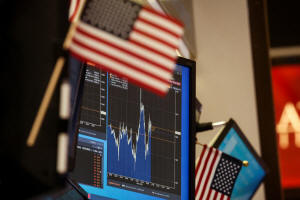Six questions facing US stock investors as 2023's second half nears
 Send a link to a friend
Send a link to a friend
 [June 29, 2023] By
Lewis Krauskopf [June 29, 2023] By
Lewis Krauskopf
NEW YORK (Reuters) - The U.S. stock market has powered higher in the
first half of this year despite numerous obstacles, from banking sector
turmoil to recurring doubts about the economy's health.
With two days left in the first half, the S&P 500 is up 14% in 2023 - a
rebound that surprised many analysts after equities’ brutal 2022
decline. The tech-heavy Nasdaq Composite has gained 29.9%, on track for
its best first-half in 40 years.
If history is a guide, stocks’ strong start may give them a tailwind in
the second half. Since 1945, the S&P 500 went on to climb an average of
8% in the second half of the year when it rose at least 10% in the first
six months, according to Sam Stovall, chief investment strategist at
CFRA.
Here are six key questions investors are posing as they assess the
market's prospects:
WHERE’S THAT RECESSION?
The U.S. economy has proven resilient in the face of the Federal
Reserve’s aggressive monetary policy tightening, so far avoiding a
recession many forecasters were predicting at the start of 2023.

While a recession is now seen as a less likely scenario this year,
economic concerns have not disappeared. A recession probability model
run by the New York Federal Reserve based on the Treasury yield curve
earlier this month projected a 71% chance of one in the next 12 months.
“The prospect of a soft-landing, at least in investors' minds, has gone
from improbable early in the year to now quite possible,” analysts at
UBS wrote. “Of course, this positive market scenario can evaporate
quickly if inflation and jobs data disappoint.”
Some analysts also worry that estimates of corporate earnings - which
are expected to rise 1.4% in 2023 for S&P 500 companies, according to
Refinitiv IBES data - will need to be adjusted sharply lower if a
downturn arrives.
HOW FAST WILL INFLATION FALL?
The annual rate of inflation has come down by half since hitting 40-year
highs last summer yet stands well above the 2% level the Fed would like
to see before it begins pulling back on monetary policy tightening. The
Fed paused rate hikes this month but is expected to raise rates again in
July.
Some investors view moderating inflation combined with resilient growth
as a so-called Goldilocks scenario that is favorable to asset prices.
CAN THE RALLY BROADEN?
A handful of megacap names such as Apple Inc and Nvidia Corp are driving
the S&P 500’s rally, creating concerns that gains may not be sustainable
unless more stocks join in.

[to top of second column] |

A screen displays a stock chart at a
work station on the floor of the New York Stock Exchange (NYSE) in
New York City, U.S., April 6, 2022. REUTERS/Brendan McDermid

While the S&P 500 has gained 14% this year, the equal-weight version
of the index -- a proxy for the average stock -- has gained just
4.2%.
The spread between the two indexes is around levels last seen during
the dot-com bubble, analysts at HSBC noted in a recent report.
“A concentration of equity returns from the largest companies is
very unlikely to continue indefinitely,” the bank's analyst wrote.
WHEN WILL AI BEAR FINANCIAL FRUIT?
Excitement over advances in artificial intelligence has helped push
stocks higher and driven up earnings estimates. Investors will watch
second-quarter results in coming weeks for clarity on how soon
companies expect financial benefits to materialize.
The S&P 500 tech sector now trades at 27 times forward earnings,
according to Refinitiv Datastream. That is above its average of 20.9
times earnings, though well below levels reached during the dot com
bubble.
WHERE ARE THE WEAK SPOTS?
The banking sector crisis resulting from Silicon Valley Bank’s
failure in March did not end up being the systemic event many had
feared, yet investors remain on the lookout for other financial
system vulnerabilities that are being exacerbated by the Fed’s most
aggressive rate hiking cycle in decades.
One such area is commercial real estate, with concerns stemming from
lingering office space vacancies from the pandemic.

CAN EQUITIES COMPETE WITH BONDS AND CASH?
Rising rates have boosted yields on fixed income assets and cash to
their highest levels in decades, finally giving investors an
alternative to equities. That does not appear to have hobbled stock
returns so far this year, but it may dull the allure of equities
going forward if rates stay elevated.
The equity risk premium -- which measures the S&P 500's earnings
yield against the yield on the 10-year Treasury note -- puts stocks
at around their least attractive levels in over a decade, according
to Truist Advisory Services.
(Reporting by Lewis Krauskopf; Editing by Ira Iosebashvili and David
Gregorio)
[© 2023 Thomson Reuters. All rights
reserved.]
This material may not be published,
broadcast, rewritten or redistributed.
Thompson Reuters is solely responsible for this content. |